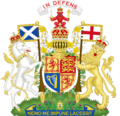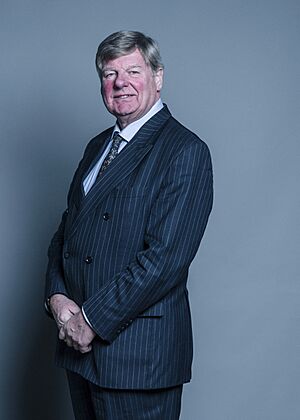Lord High Constable of Scotland facts for kids
Quick facts for kids Lord High Constable of Scotland |
|
|---|---|
 |
|
| Style | The Earl of Errol, Lord High Constable of Scotland |
| Succession | Hereditary |
The Lord High Constable is a very old and important job in Scotland. It's a "hereditary" role, meaning it's passed down through families, usually from parent to child. Today, it's mostly a "ceremonial" job, which means it's about traditions and special events rather than daily duties. In Scotland's official pecking order, the Lord High Constable used to be ranked higher than almost everyone, except for members of the royal family.
Contents
What Did the Constable Do?
Long ago, the Lord High Constable was a super important leader in the Scottish army, second only to the King of Scots himself! This person also acted as a chief judge in a special court called the High Court of Constabulary.
Judging Crimes
From the late 1200s, this court could judge serious crimes like rioting, fighting, bloodshed, and even murder. But there was a catch! These crimes had to happen within four miles of the King, the King's Council (his advisors), or the Scottish Parliament. When King James VI moved to England, the Constable's power to judge was then linked to where the King's Council was meeting.
Guarding the King
The Constable also commanded the "Doorward Guard of Partisans." This was the oldest bodyguard group in Britain! The Constable had other special honors too. For example, they had the right to sit on the King's right side during Parliament meetings. They also held the keys to Parliament House and were in charge of the King's bodyguards during ceremonies. They ranked higher than almost all other Scots, except for the royal family and the Lord Chancellor of Scotland.
Changes Over Time
However, many of these powers disappeared after Scotland and England joined together to form Great Britain in 1707. This happened because of something called the Act of Union 1707. Even though most of the old powers are gone, the job of Lord High Constable still exists as an important ceremonial role today.
A Hereditary Role
The job became hereditary in the 1100s. For a while, it was held by the Clan Comyn family. But they supported the wrong side during the Wars of Scottish Independence. Because of this, the job was taken away from them.
The Hays of Erroll
Since then, the office has been held by the Hay family, who later became known as the Earls of Erroll. The first Hay to get the job was Gilbert I de la Hay. He was given the office by the famous King Robert the Bruce after the Battle of Bannockburn. His grandson, David de la Hay, followed him in the role.
Modern Connections
Today, the Lord High Constable (who is the Earl of Erroll) and the Duke of Hamilton (as Lord of Abernethy) can sit with the Lord Lyon King of Arms. The Lord Lyon is in charge of Scottish heraldry (like coats of arms and family histories). The Earl of Erroll is also one of only four nobles who can appoint their own special messenger, called a "pursuivant." The Earl of Erroll's messenger is known as the Slains Pursuivant of Arms.
In 1952, a special court called the Court of Claims confirmed that the Countess of Erroll, as Lord High Constable, had the right to be present at the coronation of Queen Elizabeth II. She sent someone to represent her. The person who holds the job today (as of 2021) is Merlin Hay, 24th Earl of Erroll.
Scottish Soldiers in France
During the Hundred Years War, many Scottish soldiers went to fight in France. These Scottish troops had their own commanders and were quite different from their French allies. To help manage the large allied army, the French King created a special role: the High Constable of the Scots Army. This person was often called the Constable of Scotland. One of the most famous people to hold this job was John Stewart, 2nd Earl of Buchan. He later also became the Constable of France.
Some Past Constables
The job of Constable has been held by many important people throughout history. Here are a few examples:
- Hugh de Morville (1138-1162): Served King David I.
- Richard de Morville (1162-1189): Hugh's son, served King Malcolm IV.
- Alan of Galloway (1200-1234): Served King Alexander II.
- Roger de Quincy, 2nd Earl of Winchester (1234-1265): Married to a daughter of Alan of Galloway.
- Alexander Comyn, Earl of Buchan (1275–1289).
- Gilbert de la Hay (1309-1333): Made the hereditary Constable in 1314 by Robert the Bruce.
- David de la Hay (1333-1346): Gilbert's grandson.
- Thomas de la Hay (1346-1406): David's son.
- William de la Hay (1406-1437): Thomas's son.
For a full list of later Constables, you can look up the Earl of Erroll.
See also


